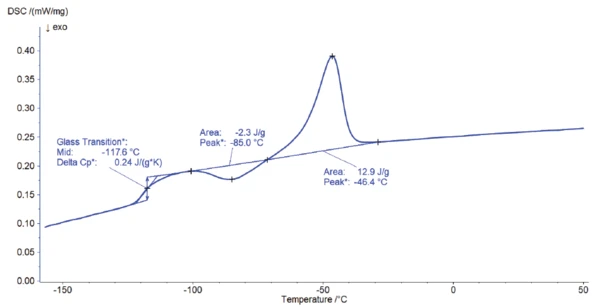Introduction
We encounter silicones, also called polysiloxanes, every day without even noticing them. For example, silicone rubbers protect car electronics from moisture and contamination, in washing machines they prevent the suds from foaming over, in shampoos they give hair a silky shine, and as silicone resin paints they keep masonry water-repellent while at the same time being permeable to water vapor and carbon dioxide from the interior. But silicones are also found in other applications that require high resistance, such as in medical technology as a pure material in medical tubes, wound pads or orthopedic products, and in electrical equipment as safe sealing and insulation materials.
Silicone are long-chained molecules containing O-Si bonds. Dependent on their molecular mass and their degree of curing, they can be found as liquids, gels or elastomers [1, 2]. This wide variety of polysiloxanes is associated with very different properties, so it is important to characterize them.
DSC Measurement Parameters
DSC is particularly appropriate for analyzing the behavior of silicones at low temperatures. In the following the thermal properties of a silicone material are determined. To this end, a DSC measurement is carried out, as described in table 1.
Table 1: Measurement Conditions
| Device | DSC 300 Caliris®, P-Module |
| Sample mass | 8.75 mg |
| Crucible | Concavus® (aluminum) with pierced lid |
| Temperature range | -170°C to 100°C |
| Heating rate | 10 K/min |
| Atmosphere | Nitrogen (40 ml/min) |
Measurement Results
Figure 1 depicts the resulting DSC curve. The endothermic step detected at -117.6°C (mid-point) is due to the Temperatura de Transición VítreaThe glass transition is one of the most important properties of amorphous and semi-crystalline materials, e.g., inorganic glasses, amorphous metals, polymers, pharmaceuticals and food ingredients, etc., and describes the temperature region where the mechanical properties of the materials change from hard and brittle to more soft, deformable or rubbery.glass transition of the material. It is associated with a change in Specific Heat Capacity (cp)Heat capacity is a material-specific physical quantity, determined by the amount of heat supplied to specimen, divided by the resulting temperature increase. The specific heat capacity is related to a unit mass of the specimen.specific heat capacity of 0.24 J/(g·K). Between -100°C and -30°C, two different effects take place. Firstly, the ExotérmicoA sample transition or a reaction is exothermic if heat is generated.exothermal peak occurs at -85.0°C, which is a Post Crystallization (Cold Crystallization)The post crystallization of semi-crystalline plastics occurs primarily at elevated temperatures and increased molecular mobility above the glass transition.post-crystallization effect. This occurs above the glass transition temperature, when the polymer chains are capable of moving freely and can therefore crystallize. Secondly, with increasing temperature, the endothermic peak detected at -46.4°C represents melting of the crystalline phase.

Summary
Silicone can withstand high temperatures well due to its material properties. Therefore, it can also be used for different applications in a wider temperature range. However, the DSC investigation shows that these results are crucial for the application range of this material at low temperatures: It will behave very differently at room temperature as compared to a temperature below the melting effect or glass transition.